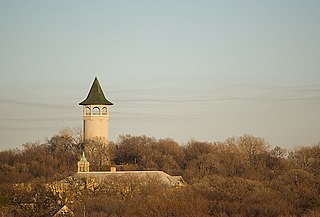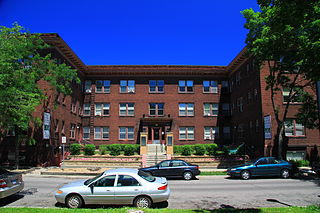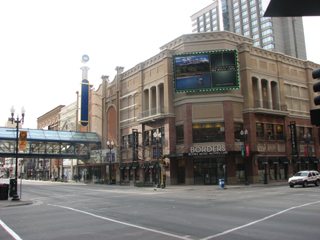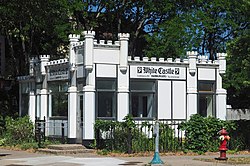
A diner is a small, inexpensive restaurant found across the United States, as well as in Canada and parts of Western Europe. Diners offer a wide range of foods, mostly American cuisine, a casual atmosphere, and, characteristically, a combination of booths served by a waitstaff and a long sit-down counter with direct service, in the smallest simply by a cook. Many diners have extended hours, and some along highways and areas with significant shift work stay open for 24 hours.

Lustron houses are prefabricated enameled steel houses developed in the post-World War II era United States in response to the shortage of homes for returning G.I.s by Chicago industrialist and inventor Carl Strandlund. Considered low-maintenance and extremely durable, they were expected to attract modern families who might not have the time or interest in repairing and painting conventional wood and plaster houses. Lustron production ceased in 1950 due to the company's inability to pay back the startup loans it had received from the Reconstruction Finance Corporation. Over 2,000 homes were constructed during the Lustron's brief production period, and many remain in use today. Several have been added to the National Register of Historic Places.

White Castle is an American regional hamburger restaurant chain with 377 locations across 13 states, with its greatest presence in the Midwest and New York metropolitan area. Founded on September 13, 1921, in Wichita, Kansas, it has been generally credited as the world's first fast-food hamburger chain. It is known for its small, square hamburgers referred to as "sliders". The burgers were initially priced at five cents until 1929 and remained at 10 cents until 1949. In the 1940s, White Castle periodically ran promotional ads in local newspapers which contained coupons offering five burgers for ten cents, takeout only. In 2014, Time named the White Castle slider "The Most Influential Burger of All Time".

The Chicago Water Tower is a contributing property and landmark in the Old Chicago Water Tower District in Chicago, Illinois, United States, that is listed on the National Register of Historic Places. Built to enclose the tall machinery of a powerful water pump in 1869, it became particularly well known when it survived the Great Chicago Fire of 1871, although the area around it was burnt to the ground.

The North Loop, also commonly called The Warehouse District, is a neighborhood of the Central community of Minneapolis, Minnesota that was Minneapolis's main commercial district during the city's years as a midwestern shipping hub. Although only a little commercial shipping is still done in the neighborhood, the historic warehouses still dominate the neighborhood. Some of these buildings have been repurposed into restaurants, shops, and apartments.

Prospect Park is a historic neighborhood within the University community of the U.S. city of Minneapolis, Minnesota. The area is bounded by the Mississippi River to the south, the City of Saint Paul, Minnesota to the east, the Burlington Northern railroad yard to the north, and the Stadium Village commercial district of the University of Minnesota to the west. The neighborhood is composed of several districts which include the East River Road area. The 1913 Prospect Park Water Tower is a landmark and neighborhood icon.

Kewpee Hamburgers is the second oldest chain of hamburger fast-food restaurants, founded in 1923 in Flint, Michigan under the name "Kewpee Hotel Hamburgs". Kewpee's current headquarters is located in Lima, Ohio. The chain is named after the Kewpie doll. Kewpee was one of the first to institute curbside service, which later morphed into a drive-in service, and then finally was transformed into drive-thru service. The Lima Kewpee locations have locally raised beef delivered daily to each Kewpee restaurant. The Kewpee Restaurant in Lima, Ohio is considered a historic site.

Saint Anthony Main refers to an area of buildings with multiple owners located on Main Street across from Saint Anthony Falls in the Nicollet Island/East Bank, Minneapolis section of Southeast, Minneapolis in the U.S. state of Minnesota. Commonly the area is associated with Northeast, Minneapolis as it is actually northeast of downtown on the east side of the Mississippi River. It opened as a festival marketplace in the 1980s.

White Tower Hamburgers was a fast food restaurant chain that was founded in 1926 in Milwaukee, Wisconsin. With its similar white fortress-like buildings and menu it is considered to be an imitator of White Castle chain that was founded in 1921. The chain was successful and expanded to other cities, including Chicago, Indianapolis, Cleveland, Dayton, Detroit, Philadelphia, Pittsburgh, Baltimore, New York City, Albany, Boston, Richmond, Virginia, and as far south as Sarasota, Florida. During the Great Depression, White Tower sold hamburgers for five cents. The whiteness of the restaurant was meant among other things to evoke the notion of hygienic conditions, and the chain had staff dressed as nurses, dubbed the "Towerettes," to help make this argument.

The Midtown Exchange is a historic structure and mixed-use building located in the Midtown neighborhood of Minneapolis, Minnesota, United States. It is the second-largest building in Minnesota in terms of leasable space, after the Mall of America. It was built in 1928 as a retail and mail-order catalog facility for Sears, which occupied it until 1994. It lay vacant until 2005, when it was transformed into multipurpose commercial space. The building is listed on the National Register of Historic Places as the Sears, Roebuck and Company Mail-Order Warehouse and Retail Store.

Stevens Square is the southernmost neighborhood of the Central community in Minneapolis. Although one of the densest neighborhoods in Minneapolis today, the land was originally occupied by a few large mansions. Today, the area is composed mostly of old brownstone apartment buildings or mansions that have been subdivided into apartments, giving the neighborhood a heavy population density within its small geographical area; a short and wide neighborhood, it is nearly a mile long but only three blocks tall. Much of the neighborhood is a National Historic District, and five of the apartments were listed on the National Register of Historic Places in 1993.

Mayo Clinic Square on Block E in downtown Minneapolis, is a building bounded by Hennepin Avenue, North 6th Street, North 7th Street, and 1st Avenue North. It is part of the Downtown West neighborhood in Minneapolis, historically known as the Warehouse District. It is one block south of the Warehouse District/Hennepin Avenue light rail station on the METRO Blue and Green lines. "Block E" is a City planning department designation of the block; other blocks have similar designations

Childs Restaurants was one of the first national dining chains in the United States and Canada, having peaked in the 1920s and 1930s with about 125 locations in dozens of markets, serving over 50,000,000 meals a year, with over $37 million in assets at the time. Childs was a pioneer in a number of areas, including design, service, sanitation, and labor relations. It was a contemporary of food service companies such as Horn & Hardart, and a predecessor of companies such as McDonald's.

Tanpopo Ramen and Sake Bar is a historic diner in Albany, New York, built in 1941 and located at 893 Broadway, one of the oldest streets in Albany. Used as a set for the 1987 film Ironweed, which starred Jack Nicholson and Meryl Streep, it was added to the U.S. National Register of Historic Places in 2000.

The Lustron Houses of Jermain Street Historic District is located along that street in Albany, New York, United States. It consists of five prefabricated homes built by the Lustron Corporation after World War II. It was recognized as a historic district and listed on the National Register of Historic Places in 2009.

The Northwestern National Life Insurance Company Home Office, was also known as the Loring Park Office Building, and is now a 75 unit boutique apartment complex known as 430 Oak Grove located in Minneapolis, Minnesota. It was designed by the architecture firm of Hewitt and Brown in the Beaux-Arts style as the headquarters of the Northwestern National Life Insurance Company. The building was listed on the National Register of Historic Places on July 16, 2012.

The Band Box Diner is the oldest operating diner in the Elliot Park neighborhood of Minneapolis, Minnesota. The restaurant, located at 729 South 10th Street, is modeled on the White Castle chain, but is entirely locally built. It was opened by Harry Wyman and his wife Bert in 1939. They eventually built 15 Band Boxes in the chain by 1950. All of the restaurants were in Minneapolis, with the exception of one in Columbia Heights. In 1953, the Wymans sold the chain, and by 1972, this location was the only one that remained. It was purchased in 1998. Its new owners hired architects Robert Roscoe and Karen Gjerstad to plan the restoration and expansion of the building.
Tee Pee Restaurant was a drive-in restaurant in Indianapolis, Indiana, that began business in 1932. In 1939, the original building on Fall Creek Boulevard was replaced with one having a central stuccoed teepee-shaped section with identical flanking wings. A cantilevered canopy extended around the building. Additions were made to the wings in 1952.

WaHu Student Apartments is a luxury residential apartment building located in Minneapolis, Minnesota. It was first announced in 2012 with intent to cater to the campus population of the nearby University of Minnesota. The complex comprises 327 residential units within three apartment towers. It also contains designated retail space, currently leased by tenants such as Bank of America, Blaze Pizza, and local restaurants.

The White Castle Restaurant is a historic restaurant building, built in Columbus, Ohio. It was listed on the Columbus Register of Historic Properties in 1984. The building was moved to Orient, Ohio in 1986, replaced with a new White Castle building. The site in Columbus is currently vacant.




















